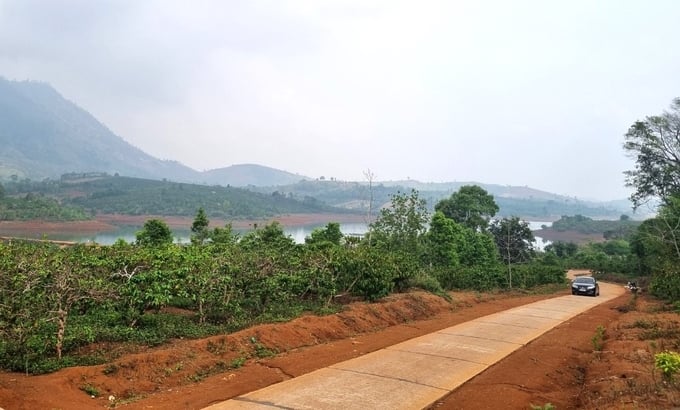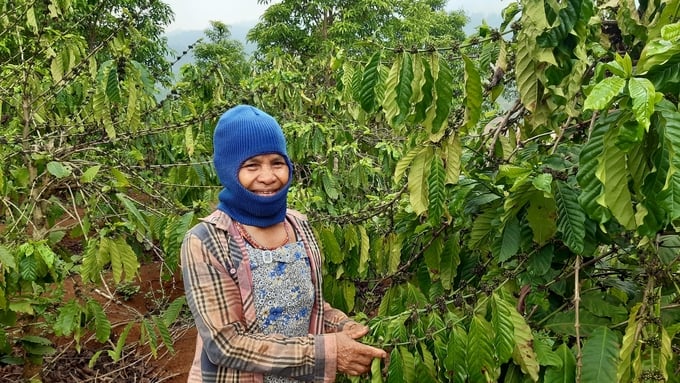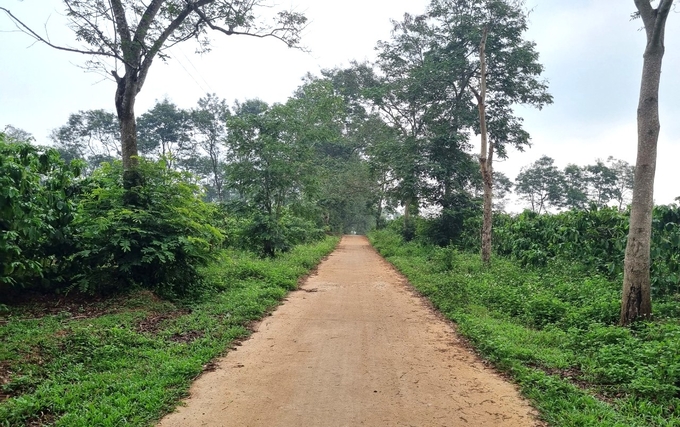May 25, 2025 | 18:46 GMT +7
May 25, 2025 | 18:46 GMT +7
Hotline: 0913.378.918
May 25, 2025 | 18:46 GMT +7
Hotline: 0913.378.918

Landscape coffee will be a lever for local economic development. Photo: Dang Lam.
Coffee gardens in Dak Krong commune (Dak Doa district, Gia Lai) are increasingly popular as one of five locations in the Central Highlands selected to implement a pilot project to develop sustainable coffee with the landscape approach. This is an initiative of the Vietnam Sustainable Agriculture Transformation Project (the VnSAT project).
According to Mr. Ha Van Kien, Vice Chairman of Dak Krong People's Committee, the commune is chosen to implement the landscape coffee development model because it has a large coffee area located in the landscape area. Dak Krong also has rivers, mountains, hydropower reservoirs, and especially ethnic villages with the potential to develop tourism through preserving the traditional cultural identity.
The VnSAT project has invested in many items, the highlight of which is the concrete road from the commune down to the heart of Dak Doa lake. The road is more than 3 m wide, winding around the village of Dak Mong of the BahNar people, through the vast and green coffee gardens, sometimes up the hills where the specialty fruit is growing. It reaches its end at the water's edge of the reservoir of Dak Doa hydropower reservoir. Along the road leading to Dak Mong village (Dak Krong commune) is a row of cassia trees standing proudly against the wind, covering thousands of green coffee, avocado, and durian below.

Concrete roads are built in the landscape coffee area. Photo: Dang Lam.
One thing to note is that the gardens here are evergreen and full of fruit. This is thanks to nature's blessing: suitable soil, fresh climate, and abundant irrigation water. Through the project, the BahNar people here also know how to apply the advances of science and technology to the production of coffee and other crops.
The sky is blue and so is the water, matched with the green coffee gardens to create a wonderful landscape. The land also hides the abundance and fullness of this village of more than 200 households and more than 1,000 BahNar people.
The coffee landscape model in Dak Krong commune is very methodically and scientifically designed. The eastern area from the banks of Dak Tong stream to residential areas in the center of the commune is cultivating coffee with a density of about 1,330 trees per ha. The ratio of the area with intercropping is approximately 15%, 25% of the area is expected to be replanted and 75% will be improved. The main intercropping crops are avocado, durian, and litsea.
At the top of the hill there lies residential areas and basic construction works. The commune will continue to arrange residential areas, offices of agencies, cooperative offices, cultural works, markets and other basic constructions.
On the west side of the hill there is the coffee replanting are (22%) and the coffee improving area (78%), intercropped with specialty fruit trees to attract tourists. The area is adjacent to the Dak Doa hydropower reservoir, and camping spots will be open for tourists to picnic. Around the Dak Doa hydropower reservoir, next to the existing aquaculture area of Dak Krong Cooperative, there will be a floating restaurant, a marina and recreational fishing spots.

Yel's family mainly relies on coffee. Photo: Dang Lam.
Thanks to the VnSAT project investing in the construction of the main road as well as the internal branch roads, people’s coffee harvesting and transportation have been much more convenient. "Since we have this road, we have no trouble bringing coffee from the garden back home, transporting fertilizer to the garden is also much easier than before," said Yel, a BahNar woman in Dak Mong village.
With changes occurring in the area, many sharp-witted villagers already thinking about other opportunities. When tourism is flourishing in the future, they plan to open grocery stores and sell more signature local products to increase their income. They will also have the chance to introduce to visitors the unique cultural products of the BahNar people here.

Concrete roads passing through the broad coffee gardens. Photo: Dang Lam.
Mr. Ha Van Kien, Vice Chairman of Dak Krong People's Committee, said that the implementation of the landscape coffee model has brought many practical benefits. Especially for the BahNar ethnic people who are used to farming in an outdated way, thanks to the project they can now access advanced farming methods and produce sustainable and quality coffee products. The project has also contributed to significantly changing the face of the countryside “Hopefully more and more people will know about Dak Krong commune with clean coffee products, endemic fruits, interesting natural landscapes, and the unique cultural features of the BahNar people here”.
Translated by Samuel Pham
/2025/05/25/4127-3-073637_820.jpg)
(VAN) Thanks to the promotion from an FAO-implemented project, vegetable production in greenhouses in Moc Chau has seen strong development, from 1.5 hectares in 2021 to nearly 50 hectares in 2024.

(VAN) FAO has recently supported USD 140,000 to implement the project 'Risk mitigation human-animal interface risks through disease control initiatives in pig farming.'

(VAN) The People's Committee of Tra Vinh province has approved an adjustment to the investment policy for the Green Hydrogen Plant project, increasing its area to approximately 52.76 hectares.
![Reducing emissions from rice fields: [2] Farmers’ commitment to the soil](https://t.ex-cdn.com/nongnghiepmoitruong.vn/608w/files/news/2025/05/05/dsc08881jpg-nongnghiep-140632.jpg)
(VAN) Clean rice cultivation model in Thuong Tan commune, Bac Tan Uyen district, is assisting local residents in achieving sustainable agriculture by substantially reducing costs, increasing productivity, and protecting the environment.

(VAN) At the conference to disseminate Resolution No. 68, AgriS introduced its digital agricultural ecosystem and reaffirmed its commitment to accompanying the Government in promoting private sector development and sustainable agriculture.

(VAN) 'Blue Ocean - Blue Foods' initiative is designed to restore marine ecosystems and establish sustainable livelihoods for local communities by cultivating a minimum of 1,000 hectares of cottonii seaweed in the first three years.
/2025/05/21/4642-3-112707_603.jpg)
(VAN) The V-SCOPE project has made direct contributions to three out of six pillars of the Comprehensive Strategic Partnership between Vietnam and Australia.